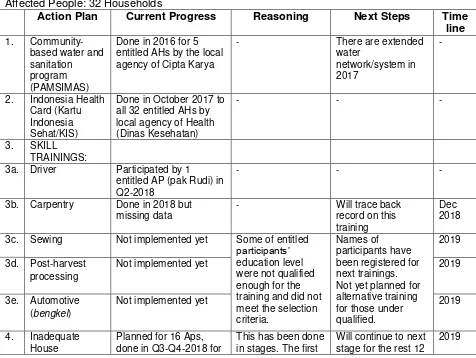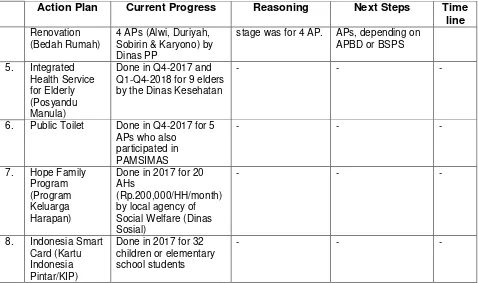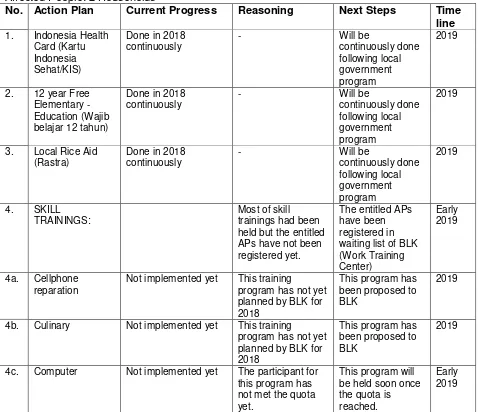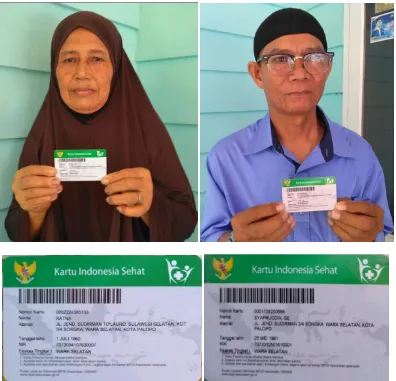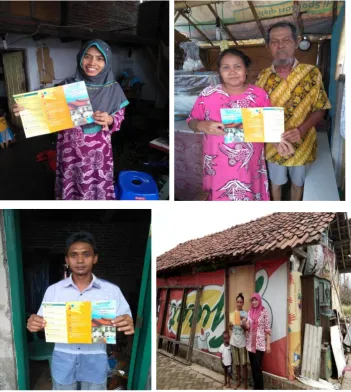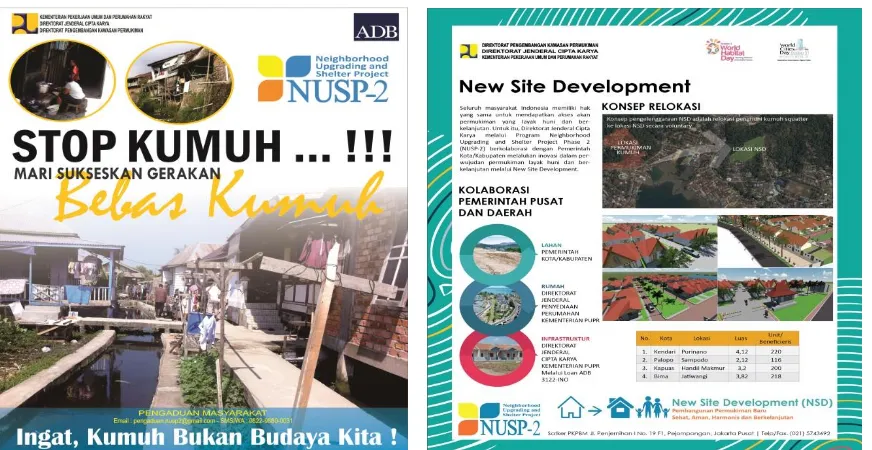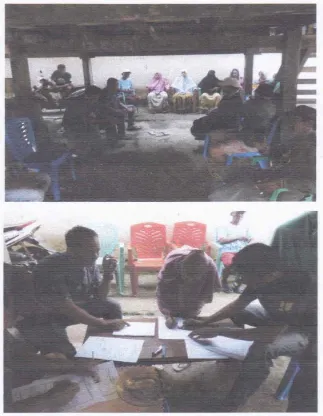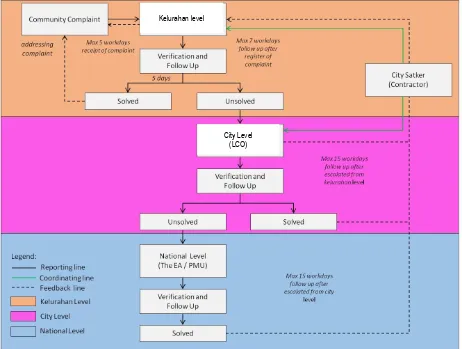2
Semi Annual Social Monitoring Report
Project Number: ADB LOAN 3122-INO
REPORTING PERIOD: JANUARY– JUNE 2018
INDONESIA: NEIGHBORHOOD UPGRADING AND
SHELTER PROJECT PHASE 2
Financed by the
Asian Development Bank
Prepared by:
3
Table of Contents
LIST OF TABLES ... 4
LIST OF FIGURE ... 4
LIST OF APPENDICES ... 4
ABBREVIATION ... 5
CHAPTER I. PROJECT BACKGROUND AND DESCRIPTION ... 6
CHAPTER II. PROJECT IMPLEMENTATION PROGRESS ... 8
CHAPTER III. RESETTLEMENT... 10
CHAPTER IV. COMPENSATION AND INCOME RESTORATION PROGRAM ... 11
CHAPTER V. LAND DONATION ... 15
CHAPTER VI. DISCLOSURE, CONSULTATION AND PARTICIPATION ... 18
6.1. Disclosure ...18
6.2. Public Consultation/Information Dissemination Meetings ...19
CHAPTER VII. GRIEVANCE REDRESS MECHANISM (GRM) ... 21
CHAPTER VIII. INSTITUTIONAL ARRANGEMENT AND CAPACITY BUILDING ... 24
CHAPTER IX. CONCLUSION AND CORRRECTIVE ACTIONS ... 26
9.1. Conclusion ...26
9.2. Corrective Actions ...26
4
LIST OF TABLES
Table 1. Progress of Income Recovery Program for Pekalongan Complex Civil Work 2016... 11
Table 2. Progress of Income Recovery Program for Kapuas Complex Civil Work ... 12
Table 3. Progress of Income Recovery Program for Palopo New Site Development ... 13
Table 4. General Progress on Land Handover for Community Contracts ... 17
Table 5. Pending Issues and the Corrective Actions ... 26
LIST OF FIGURE
Figure 1. Initial Progress of Purirano NSD Infrastructure Construction in Kendari ... 9Figure 2. Beneficiaries of Income Recovery Program in Palopo (Indonesia Health Card) ... 14
Figure 3. Leaflet dissemination to the APs in Pekalongan ... 18
Figure 4. Two of seven posters of NUSP-2 project ... 19
Figure 5. Door-to-door consultation to the APs in Pekalongan by Community Advisors ... 19
Figure 6. Photo Documentation of Kelurahan Meeting (Muskel) III in Ponjalae, Palopo ... 20
Figure 7. Work Flow of Grievance Redress Mechanism ... 22
Figure 8. Information Disclosure for GRM Mechanism in Poster ... 23
LIST OF APPENDICES
Appendix 1. Initial Sreening on Involuntary Resettlement and Land Contribution in Complex Civil Works 2018 ... 28Appendix 2. Initial Sreening on Involuntary Resettlement and Land Contribution in Community Contract 2018 ... 29
Appendix 3. Statement of Land Donation in Palopo ... 33
Appendix 4. Community Land Information Sheet in Palopo ... 34
Appendix 5. Minutes of Meeting in Kelurahan Ponjalae ... 36
5
ABBREVIATION
ADB Asian Development Bank
AH Affected Household
AP Affected People
APBD Anggaran Pembangunan dan Belanja Daerah (Regional Budget Planning) BPJS Kesehatan Badan Penyelenggara Jaminan Sosial Kesehatan (Social Security for
Health)
BPN Badan Pertanahan Nasional (National Land Agency)
BSPS Bantuan Stimulan Perumahan Swadaya (Self-help Housing Assistance)
CA Community Adviser
CC City Coordinator
CDD Community-Driven Development
CIO Community Implementing Organization
DED Detailed Engineered Design
DDR Due Diligence Report
DGHS Directorate General of Human Settlement
EA Executing Agency
FGD Focus Group Discussion
FY Fiscal Year
GAP Gender Action Plan
GRM Grievance Redress Mechanism
Ha Hectare
HH Household
IP Indigenous People
LARP Land Acquisition and Resettlement Plan
LCO Local Coordinating Office
LG Local Government
MDG Millennium Development Goals
NMC National Management Consultant
NSD New Site Development
NPW Nilai Perkiraan Wajar (Reasonable Reimbursement Value)
NUAP Neighborhood Upgrading Action Plan
NUSP-2 Neighborhood Upgrading and Shelter Program Phase 2
PDAM Perusahaan Daerah Air Minum (local government owned clean water provider)
PIP Pengembangan Infrastructure Pemukiman (Settlement Infrastructure
Development)
PIU Project Implementing Unit (Satker or Satuan Kerja)
PMU Project Management Unit
PPP Public Private Partnership
PWH Public Works and Housing
RAB Rencana Anggaran Belanja (Project Budget)
RMC Regional Management Consultant
RP Resettlement Plan
RTRW Rencana Tata Ruang dan Wilayah (Spatial Plan)
RT/RW Rukun Tetangga/Rukun Warga (Subdivision Institution under RW/ Subdivision Institution under Kelurahan)
Satker PKPBM Satuan Kerja Peningkatan Kualitas Permukiman Berbasis Masyarakat (National PIU of Settlement Quality Improvement)
SIAP Slum Improvement Action Plan
6
CHAPTER I. PROJECT BACKGROUND AND DESCRIPTION
1. Approved on 31 March 2014, NUSP2 is aimed to upgrade basic public infrastructure in slums, and contribute to meeting Millennium Development Goals (MDGs) targets for achieving significant improvement in the lives of slum dwellers (MDG target 7D) and halving the proportion of urban households without sustainable access to safe drinking water and basic sanitation (MDG target 7C). The Project contributes to the implementation of the Cities without Slums Program launched by the Government to address issues of the rapid urbanization. The project covers 20 cities and improves basic infrastructure and living conditions in selected slums.
2. NUSP Phase 2 assists 20 cities to develop and implement inclusive pro-poor city development plans. The project improves living conditions in slum areas through (i) providing resources to local governments and communities for upgrading basic infrastructure in slum areas, (ii) strengthening planning and management capacities of local administrations for inclusive pro-poor urban planning, (iii) establishing sustainable mechanisms to engage communities in urban development planning processes, and (iv) launching public private partnerships (PPPs) to establish affordable housing areas for poor families.
3. As stipulated in the Project Data Sheet, the NUSP-2 has a Safeguard Category B for Involuntary Resettlement and Category C for Indigenous Peoples. The Category B means the project will not include physical displacement and loss of more than 10 percent of productive assets (income generating) of 200 or more persons due to involuntary land acquisition. And the Category C for Indigenous Peoples means that the Project is not expected to have any negative impacts on indigenous people, as there are no indigenous people reported in location nearby the project locations.
4. Since the project adopts Community-Driven Development (CDD) approach, the specific intervention is identified by the community members only during project implementation, thus potential issues related to land acquisition is identified only at later stage. In the context of specific neighborhood upgrading activities, i.e. construction of public sanitation facilities, small land portions might be acquired from community members or donated voluntarily. Land required for new settlement for poor families will be provided by participating districts/cities government and resettlement issues are not expected or to be minor.
5. The expected impact of the NUSP-2 is improved living conditions in urban areas. The outcome is improved infrastructure and access to service delivery in slum neighborhoods in 20 project cities. As for the outputs, the NUSP-2 has three outputs: (i) Institutional capacities for managing pro-poor urban development strengthened; (ii) infrastructure in slum neighborhoods upgraded; and (iii) new settlements for poor families established.
6. In efforts to improve infrastructure in slum neighborhoods effectively, the infrastructure activities under NUSP-2 are grouped into three categories of work packages:
1). Community contracts (skala lingkungan); 2). Complex civil works (skala kawasan); 3). New Site Development.
7 have formulated 214 Community Action Plans (CAPs or RKM, Rencana Kerja Masyarakat) for first cycle in 99 neighborhoods (kelurahan) of 20 cities.
8. The complex civil works activity is designated to infrastructure construction works which implemented by contracted firm selected through bidding process. This kind of complex construction works may have scope across neighborhoods and usually requires advanced or heavy equipments. The DED and budget of this package is prepared by consultants hired by APBD. This year, 9 complex civil works were actually implemented in 8 cities.
9. The New Site Development (NSD) Construction Activity. The NSD plans to construct the public facilities and infrastructures for the newly built neighborhood, such as paving roads, drainage system, clean water supply, solid waste management system and landscape for open green space. There are 4 (four) cities/districts participating in the NSD projects, namely: Kendari City, Palopo City, Bima City and Kapuas District. The NSD activity is also implemented by contracted firm selected through bidding process, but has many types of infrastructure works in a new land including house construction which implemented by the DGHP. Up to end of June 2018, the progress of NSD in Kendari was in construction process. In Palopo, the NSD contract was signed in June and would be followed up by construction works, while in Kapuas and Bima the data is still being collected and the sites are being prepared.
8
CHAPTER II. PROJECT IMPLEMENTATION PROGRESS
11. Community Contract Activity. During the first half of 2018, the NUSP-2 Project was conducted in 99 neighborhoods (kelurahans) within 20 cities. Community Implementing Organizations (CIO or BKM, Badan Keswadayaan Masyarakat) assisted by Community Advisors (CA) have formulated 214 Community Action Plans (CAPs or RKM, Rencana Kerja
Masyarakat) for first cycle (Siklus I) in all 99 kelurahans. Some of the planned community
contracts need small land portions through voluntary land donation, which are subject to basic principle of land donation in Resettlement Framework Paragraph 29, 30 and 31.
12. Complex Civil Works Construction Activity. The planning documents of 9 work
packages in 8 cities/districts have been formulated by consultants, which were recruited by local government’s Budget/APBD of fiscal year 2018. It was planned for 11 complex civil work packages in 10 cities, but two sites could not secure vacant land for the construction and cancelled the subprojects. The planned work packages need small land portion from community, which are provided through voluntary land donation, without any physical relocation. Hence, neither land acquisition report and resettlement plan will be required.
13. However, as the project implementation in complex civil works in Kapuas District and Pekalongan City in 2016 have affected 149 peoples or 38 households and caused resettlement, a Resettlement Due Diligence Report has been prepared and secured ADB approval for each location. Such report provides information about the process of resettlement which do not excess the major impact, and the affected people were provided with proper entitlement, as well as adequate recovery programs. The monitoring of these recovery programs will be further elaborated in Chapter IV Compensation and Income Restoration Program.
14. New Site Development. The Purirano NSD infrastructure construction contract in
9
Figure 1. Initial Progress of Purirano NSD Infrastructure Construction in Kendari
15. In Palopo City, the construction contract of NSD Sampoddo was signed in June 2018 and will be followed with the construction implementation which will start on 18 July 2018 (Pre-construction Meeting). The income recovery and livelihood program designated for two Affected Households (AHs) will be reported in Chapter IV.
10
CHAPTER III. RESETTLEMENT
17. During this reporting period (January-June 2018), no involuntary resettlement (IR) were reported. It is confirmed through the initial screening of involuntary resettlement which undertaken in April 2018. The matrix of involuntary resettlement initial screening is presented in
11
CHAPTER IV. COMPENSATION AND INCOME RESTORATION PROGRAM
19. As of June 2018, within this reporting period, no land acquisition and resettlement issues emerged during construction activities, except in Kapuas District and Pekalongan City. Having said in previous Chapter that there are resettlement issues in Kapuas District and Pekalongan City, this chapter will further describe the compensation and income restoration program for the affected peoples (APs) in the said two locations. Compensation payments to AHs in Kapuas and Pekalongan had been completed, and some income recovery programs for AHs have been implemented partially by respective LGs under their budget since 2017. No resettlement program needed for other locations.
20. As for the follow-ups to the complex civil work in Pekalongan City in 2016, the local governments has identified suitable recovery programs to be offered to the affected people in the second half of 2017. The implementation progress of the income recovery program was commenced and reported in the following Table 1. The pictures of training activities and the copy of driving skill certificate of the AP (Mr./Pak Rudi) will be provided in the next report as these need to be re-issued (missing in transfer). The driver training had been provided by the BLK (Balai Latihan Kerja or Work Training Center) with proper curriculum according to the national standard. This training brought positive impact to the AP, as Pak Rudi was very delighted with the training and now he has better income as a driver.
Table 1. Progress of Income Recovery Program for Pekalongan Complex Civil Work 2016
Affected People: 32 Households
Action Plan Current Progress Reasoning Next Steps Time
line entitled AHs by the local agency of Cipta Karya
Done in October 2017 to all 32 entitled AHs by local agency of Health entitled AP (pak Rudi) in Q2-2018
3c. Sewing Not implemented yet Some of entitled
participants’
Not implemented yet 2019
3e. Automotive (bengkel)
Not implemented yet 2019
12
Action Plan Current Progress Reasoning Next Steps Time
line by the Dinas Kesehatan
- - - programs to be offered to the affected people in the second half of 2017. The implementation of the income recovery program in this location was not yet commenced since the local government faced the difficulties to allocate the budget for these activities in the APBD (local government budget), as presented in Table 2.
Table 2. Progress of Income Recovery Program for Kapuas Complex Civil Work
Affected People: 6 Households
No. Action Plan Current Progress Reasoning Next Steps Time
line
1. Indonesia Health Card (Kartu Indonesia Sehat/KIS)
Not implemented yet The budget for all activities of
4a. Sewing Not implemented yet
Q2-2019
4b. Rattan Not implemented yet
Q2-2019
4c. Carpentry Not implemented yet
13
No. Action Plan Current Progress Reasoning Next Steps Time
line
4d. Automotive Not implemented yet Kerja/BLK) Q2-2019
4e. Welding Not implemented yet
Q2-2019 4f. Construction
Works
Not implemented yet
Q2-2019
22. The New Site Development activities in Palopo City occupied the required land through land acquisition from two local land owners. This land acquisition was considered to have severe impact to the owner due to the quantity of land acquired, hence the livelihood recovery program was offered to the affected households. Details on this land acquisition process and its livelihood recovery program was reported in the Land Acquisition Report for NSD Palopo. The implementation of this program has been conducting partially as presented in the following Table 3. The pictures of the APs with their Indonesia Health Cards are shown in Figure 2 in the next page.
Table 3. Progress of Income Recovery Program for Palopo New Site Development
Affected People: 2 Households
No. Action Plan Current Progress Reasoning Next Steps Time
line
Not implemented yet This training
program has not yet
4b. Culinary Not implemented yet This training
program has not yet
14
15
CHAPTER V. LAND DONATION
23. The relevant basic principles set forth in the Resettlement Framework document (paragraph 29, point a, d, g and i) to be applied for the projects are as follows:
(i) Acquisition of land and other assets shall be avoided and minimized as much as possible by exploring project and design alternatives and appropriate social, economic, operational, and engineering solutions that have the least impact on populations in the project area.
(ii) APs shall be fully consulted and informed on the project, their entitlement and resettlement options. As well as the assistance measures. Ensure the APs participation in planning, implementation, and monitoring and evaluation of resettlements programs. Particular attention will be provided to the vulnerable groups and ensure their participation in consultations.
(iii) There shall be an effective grievance redress mechanism to receive and facilitate resolution of the affected persons’ concern during the preparation and
implementation of LARPs.
(iv) Appropriate monitoring shall be carried out to assess land acquisition objectives and their impacts on the standard of living of the APs. The M& E, mechanisms shall be identified and set in place as part of the land acquisition management system. Monitoring reports should be disclosed.
24. As the project of the NUSP-2 are specific neighborhood upgrading activities, only small land portions acquired from community members or donated voluntarily. Land required for the new settlement for poor families in NSD sites would be provided by participating district or city governments. Hence, the resettlement issues are not expected to occur or just minor.
25. Concerning the basic principles point (ii), prior to the commencement of construction works in NUSP-2 subprojects, there are socialization or information dissemination meeting for the potential affected people to be fully informed and consulted about the project, their entitlement and resettlement option. More on this information disclosure will be discussed in Chapter VI. Disclosure, consultation and Participation.
26. As for the basic principles point (iii), the NUSP-2 has developed grievance redress mechanism to receive and facilitate the AP’s concerns, and will be further described in Chapter VII. The appropriate monitoring will be carried out and the monitoring report would be disclosed.
27. When the project construction activities require a small land acquisition, the project communities or individuals may decide to make voluntary contribution of the affected land and non-land assets. It occurs that the affected land owners did not demand any compensation in return. The land donation shall not cause significant loss to the owner and the owner must be a direct beneficiary of the project. According to the resettlement framework, this shall be acceptable only if the following requirements are in place:
(i) Full consultations with the land owners and any non-titled displaced persons on site selection;
16 sanctioned measures to replace any losses that are agreed to through verbal and written record by the APs;
(iii) No any coercion to those who are opted for the contribution;
(iv) Any voluntary “donation” will be confirmed through verbal and written record and verified by an independent third party such as a designated non-government organization or legal authority;
(v) Having adequate grievance redress mechanism in place; and
(vi) Safeguards must be built into the community decision making process and included in the project implementation guideline to be followed by project consultants and facilitators and shared with the project community members. 28. As the NUSP-2 adopts the CDD approach, the specific intervention is identified by the community members themselves during project implementation. So the land owners and any non-titled displaced person are fully consulted through series of kelurahan meeting (Muskel). The process of land provision that may need land donation has been done in an open and transparent manner through the Muskel II and III. However, the communities are not aware of requirement to confirm this voluntary donation through verbal or written record by an independent third party as required in point (iv) of paragraph 28 above (paragraph 30 of RF document). There is no documentation of such confirmation as well due to poor documentation at the community level. The project is in the process of recruiting an independent individual as the third party to verify verbal or written records of voluntary land donation process. All the process of these land donations have still been partially complied with the RF procedure as set forth in paragraph 29-31 of RF document, and will be improved in the FY 2018 land donation procedures.
29. Land donation by beneficiary households is acceptable where:
(i) the impacts are marginal (based on percentage of loss and minimum size of remaining assets);
(ii) impacts do not results in displacement of households or cause loss of household’s incomes and livelihood;
(iii) the households making land donations are direct beneficiaries of the project; (iv) donated land is free from any dispute on ownership or any other issues; (v) consultations with the affected households are conducted in a free and
transparent manner;
(vi) land transactions are supported by transfer of titles; and
(vii) proper documentation of consultation meetings, grievances, and action taken to address such grievances is maintained
17 31. In total, there are 54 sites of donated land accompanied with the respective donation statements. Eight (8) sites completed with respective usage permits, while no passing permit was required for community contract activities and no compensation demanded in return to benefits provided by the project. These sites are dispersed in 10 cities/districts, which are Bengkulu (West Region), Palangkaraya (Central Region) and Palopo (East Region). These construction activities caused no involuntary resettlement, no physical relocation or losing of their productive assets. The description of land donation process recorded in minutes, statement of land donation, list of attendance and photo documentation. As some examples,
Appendix 3 shows the statement of land donation in neighborhoods of Palopo.
32. A revised template or form for land donation document has been prepared, with some additional profile of the land owner to indicate that the impacts are marginal (based on percentage of loss and minimum size of remaining assets), and these impacts do not result in displacement of households or cause loss of household’s incomes and livelihood. These two forms would be used unanimously in all land donation document in the remaining NUSP-2 project and subproject. As some examples, Appendix 4 shows the revised form which provides the brief economic profil of the affected household. The recapitulation of land handover for community contract in 2018 is provided in Table 4 below. However, as the data of land donation in the West Region is still being collected, this will be provided and reported in the next semi-annual report.
Table 4. General Progress on Land Handover for Community Contracts
N
LAND DONATION STATUS LAND USE PERMISSION STATUS
Land
SUB TOTAL 24 15087,35 1088,75 330.520.00
18
CHAPTER VI. DISCLOSURE, CONSULTATION AND PARTICIPATION
6.1. Disclosure
34. Information on public consultation, discussion, and neighborhood meetings related to the the implementation of community and complex civil work contracts are documented and uploaded into the NUSP-2’s website (www.nusp2.id).
35. The Due Diligence Report and regular monitoring report are subject to public disclosure. Therefore, these documents will be made available to public including the affected people and related stakeholders. This Semi Annual Social Monitoring report will be uploaded on the ADB and PWH Ministry websites, as well as on the local Satker’s website. Furthermore, the information about the due diligence report will be summarized in the form of leaflet for dissemination to the affected households and peoples. These information leaflets are being prepared for public dissemination. Figure 3 below shows some pictures of how the brochures or leaflets were being distributed to the affected peoples by the community advisor (CA) in Pekalongan city.
19 36. Since the DDR for Kapuas and Pekalongan have particularly secured no objection from ADB, these documents have been published through ADB’s website and the project website and disclosed in form of leaflets to the affected persons.
37. Besides those leaflets for the APs, the project also published about six posters explaining the NUSP-2 project and one special poster on NSD. This posters dissemination is another strategy to reach out the potential beneficiaries. These posters have been distributing gradually in 2016 and 2017, and mention the email address and mobile contact number to redress grievance or complains from communities. Two of these posters are shown in Figure 5
below.
Figure 4. Two of seven posters of NUSP-2 project
6.2. Public Consultation/Information Dissemination Meetings
38. Public consultation is done to provide an opportunity for affected people including landowners who sold their land assets as well as peoples who own land next to the planned construction location. Some consultations were being conducted door-to-door by the community advisors or the city coordinator, as shown in Figure 4 below.
20 39. Specifically, the consultation is conducted to establish agreements about land boundaries, land prices, and administrative processes of handover ownership. The statement letter on the compensation payment release of the land right is signed by the two parties (seller and buyer) and the explanation of the release of land rights is also carried out and signed by local authority (sub-district head) and being witnessed by at least two persons.
40. Similar condition applies to land donation, full consultations with the land owners and any non-titled displaced persons on site selection is required to make acceptable land donation.The statement letter on release of land right is signed and acknowledge by local authority and witnessed by at least two person.
41. The public consultation/information dissemination meeting regarding land donation is documented in minutes of meeting, photos and list of attendance. As a sample of such public consultation, here is a picture of the meeting in Kelurahan Ponjalae in Palopo City held on 4 April 2018 attended by 16 men and 5 women (Figure 5). The minutes of this meeting and the list of attendees is provided in Appendix 5 and 6.
21
CHAPTER VII. GRIEVANCE REDRESS MECHANISM (GRM)
42. Grievance redress mechanism is used as an instrument to handle any complaints and/or queries which emerge during land donation process and during construction process of the NSD project. Any affected people/party will have the right to file complaints. It is anticipated that all grievances related to benefits and other assistance will be expected to be resolved at the subproject as the project upholds CDD (community-driven development) as the overarching approach.
43. The procedure for filing complaints and/or grievance during construction is established as follows:
(i) The complaint will be filed to the Badan Keswadayaan Masyarakat (BKM) or Community Implementing Organization (CIO) members and local government at the neighborhood level for an immediate solution when possible. At this neighborhood level, the PIC is the coordinator of the BKM/CIO.
(ii) If the problem cannot be solved, the BKM members and local government staff will facilitate the APs (affected peoples) to submit their complaints to the Projects’s grievance redress committee (GRC) at the district level, and to the national level if needed. Community advisor then will record the complaint and report it to the LCOs. The project will dedicate a staff at city/district and national levels to be in charge of handling and following up on AP’s complaints. The person in-charge at the city or district level is the LCO appointed personnel, and at the national level is the EA assisted by the NMC.
44. The handling procedure by GRC on complaints and/or grievance is as follows:
(i) The members of the GRC should involve the representatives of vulnerable affected people (i.e. affected women, poor and minority groups) and other affected people along with relevant government officials who have functional and legal authority. The committee will then review grievances involving all land acquisition benefits or issues, except for disputes related to ownership.
(ii) Grievances will be redressed within 2 to 4 weeks from the date of filing the complaints at the district level and within 8 weeks at the national levels. If no consensus can be reached, the dispute resolution will refer to the grievance mechanisms based on Law No. 2/2012 on Land Acquisition for the Development of Public Interest and Presidential Regulation No. 71/2012 on the Implementation of Land Acquisition for the Development of Public Interest.
45. The project is preparing to establish a grievance redress mechanism, which basically consists of three levels, i.e. at the kelurahan (neighborhood), the city/district and the national level. This leveling system is expected to timely address any complaints during project implementation. Affected people will have the right to file complaints and/or queries related to adverse impacts due to project activities. Community complaints that will emerge later on, will be handled with grievance redress mechanism in accordance with the complaint handling guidelines which had been prepared by the DGHS in this reporting period.
22 Planning Agency) and the complaints should be followed up and/or resolved within 15 workdays and the handling will be coordinated with the City Satker. If the grievance cannot be resolved at the city level, it will be escalated to the PMU/EA which representing the DGHS, at the national government level.
Figure 7. Work Flow of Grievance Redress Mechanism
47. Once the Grievance Redress Mechanism is established and disseminated to all level stakeholders and community, it shall be effectively implemented to receive complaints and facilitate resolution of the affected people during the process of Land Acquisition and Resettlement Plans (LARP) preparation and implementation. Regular report on the progress of GRM implementation will be presented in the next semi annual report.
48. To disseminate information of the GRM, in 2016 the project had published a guideline or manual (Petunjuk Teknis/Juknis) on grievance redress handling mechanism, and distributed to all LCO and City Satker. In addition to this, the project had also published a poster especially on GRM or PPM (Penanganan Pengaduan Masyarakat), as shown in Figure 7 below. So far, there was no any complaint or grievance raised from the community during and after the NUSP-2 project.
23
24
CHAPTER VIII. INSTITUTIONAL ARRANGEMENT AND CAPACITY BUILDING
49. To support the implementation of NUSP-2, there is a project management organization that includes government, community and consultants, from the central, district/city level, to the Kelurahan and the community.
50. The Directorate General of Human Settlements is the Executing Agency (EA) of NUSP-2, at the central level the EA assisted by the Project Management Unit (PMU) and the Satker PKPBM as the Project Implementation Unit (PIU). The national PIU is assisted by a national management consultant (NMC). At the city level, there is a Local Coordinating Office (LCO) of Kapuas District and City Satker of Kapuas District as a Project Implementation Unit at the city level. At the city level, a Regional Management Consultant (RMC) is assigned to assist the city satker. The Directorate General of Human Settlements is responsible for the management of LARP compiled by the LCO and Satker with the assistance of Technical Assistant (TA) on Safeguard at the RMC level. Consultants (RMC, CC, and CA) along with Satker at the city level will continue to monitor and update LARP.
51. To prepare project implementation, in January 23 – 26, 2018, the PMU held annual Technical Meeting on Project Implementation FY 2018 involving all personnel of NMC and RMCs (including CAs). The purposes of the meeting were to (i) evaluate the project implementation in 2017 in each city/district; (ii) identify the concept and readiness of FY 2018 implementation for community contract and complex civil works to ensure that all activities is in accordance with integration and collaboration approach; (iii) strengthen and accelerate the planning process, (iv) assess project impact on the alleviation of slum coverage area; (v) evaluate technical aspect on planning document (RKM, DED, RAB), (vi) optimize the utilization of MIS and (vi) formulate action plans for FY 2018. The meeting was designated to achieve specific output, such as: (i) screening process for evaluation on 99 targeted neighborhoods, and (ii) formulation on FY 2018 implementation concept, strategies, and collaboration approach in each targeted neighborhood.
52. PMU also performed other activities in February 26-28, 2018: Workshop Evaluation of Implementation in FY 2017 and Preparation for FY 2018 Implementation attended by local government (Satker, PPK and LCO of 20 participating city/district). The purpose of the meeting was to (i) evaluate the project implementation in 2018 in each city/district; (ii) ensure the readiness of local governments in the project implementation for 2018, particularly in relation to the project preparations, project management, and asset management; (ii) examine initial implementation issues; (iii) formulate action plans for 2018 and discussion on planning document (Detailed Engineering Design / DED) for complex civil works FY 2018. The specific output such as: improve the understanding of local government of 20 project cities / district on the overall project delivery including planning, implementation, monitoring, and evaluation; finalization on planning document (particularly DED for complex civil works) on the 99 selected neighborhood and in addition, to update action plan for 2018 implementation.
26
CHAPTER IX. CONCLUSION AND CORRRECTIVE ACTIONS
9.1. Conclusion
54. Based on the monitoring, review and some analyses of social impacts on the local community livelihoods and assets, within this reporting period the NUSP-2 projects and subprojects did not include physical displacement and loss more than 10 percent of productive assets and income generation. No land acquisition and involuntary resettlement issues emerged during construction activities.
55. In Kapuas District, the livelihood restoration program are also being provided for the affected peoples (APs) but yet the implementation will be started in the FY 2019 since the local government faced difficulties to allocate budget for the recovery programs in the FY 2018. 56. In the monitoring on the implementation of DDR or Land Acquisition Report for the NSD in Palopo, the offered livelihood recovery program implementation was not fully commenced. The remaining will be commence in the next fiscal year and be reported in the next Semi Annual Monitoring Report.
57. In general, for this reporting period the social safeguard requirements for NUSP-2 is still partially complied, as there are some action plans in income recovery programs that have not been conducted fully.
9.2. Corrective Actions
58. Some pending issues or gaps in livelihood recovery program implementation in Pekalongan, Kapuas and Palopo will require close monitoring and commitment by local governments to manage the implementation in timely schedule. These corrective or remedial actions will be monitored and also reported in the next Semi Annual Monitoring Report.
Table 5. Pending Issues and the Corrective Actions
Pending Issues Corrective Actions need to
be done to the local government to ensure the implementation
- Recruiting an independent third party or individual consultant through an open bidding process.
27
28
Appendix 1.Initial Sreening on Involuntary Resettlement and Land Contribution in
29
Appendix 2. Initial Sreening on Involuntary Resettlement and Land Contribution in Community Contract 2018
No City/District Kelurahan
30
No City/District Kelurahan
31
No City/District Kelurahan
32
No City/District Kelurahan
33
34
36
38

